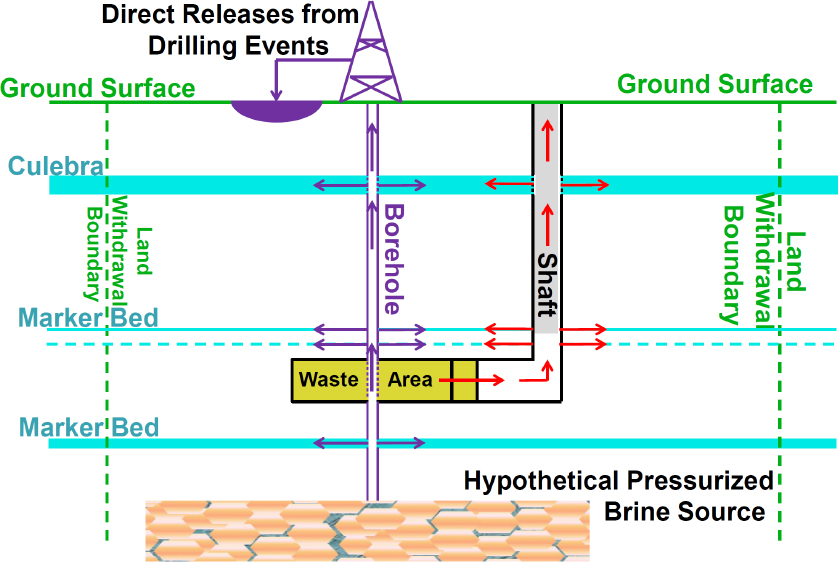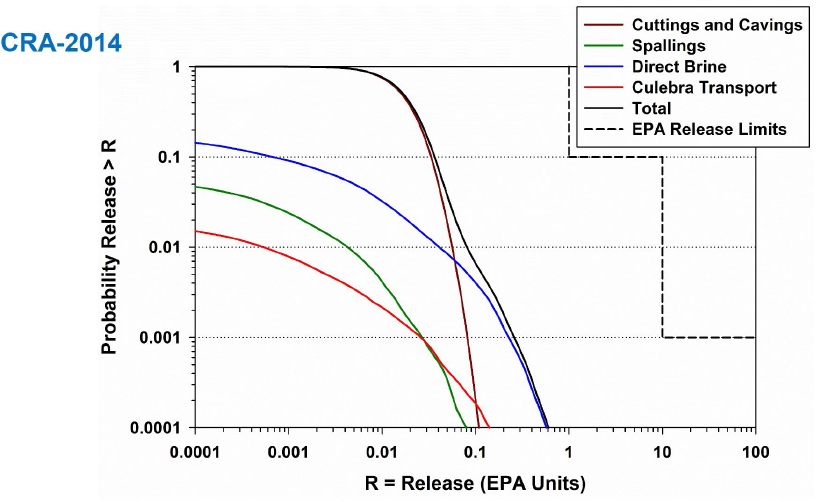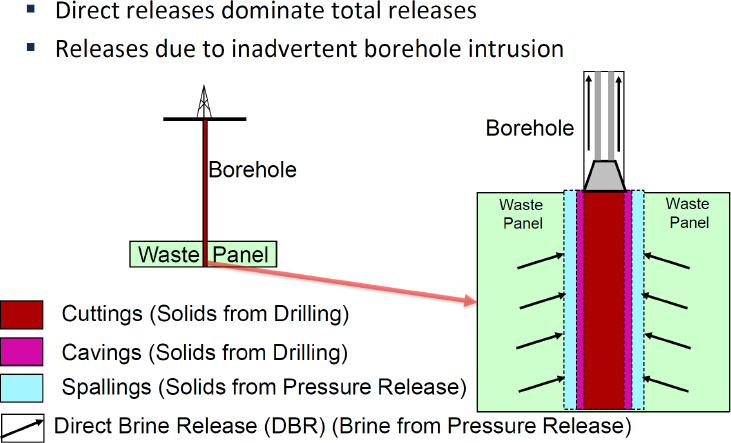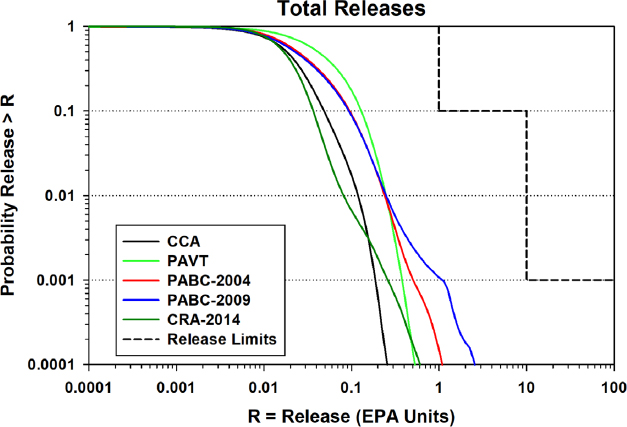Appendix C
How Salt Repositories Work
DISPOSAL
All radioactive waste has the potential to present a hazard to people and to the environment and must be managed to reduce any associated risks to acceptable levels. The end state for radioactive waste is disposal. As noted in the International Atomic Energy Agency (IAEA) Safety Standards Series No. SSR-5 (IAEA, 2011, p. 3), the aim of disposal is
- To contain the waste;
- To isolate the waste from the accessible biosphere and to reduce substantially the likelihood of, and all possible consequences of, inadvertent human intrusion into the waste;
- To inhibit, reduce, and delay the migration of radionuclides at any time from the waste to the accessible biosphere;
- To ensure that the amounts of radionuclides reaching the accessible biosphere due to any migration from the disposal facility are such that possible radiological consequences are acceptably low at all times.
All radioactive waste disposal facilities including deep geological repositories share a basic objective in their design, operation, and closure: to provide reasonable assurance for the containment and isolation of the waste and limiting releases that would pose a threat to human health and the environment. Confidence in the containment and isolation performance is evaluated over timescales relevant to the risk posed by the hazard using models.
During the operational (pre-closure) phase of a disposal facility, such assurance of safety is intended to be provided by, for example, the waste container, waste acceptance criteria, and engineering and administrative controls. After repository closure (and any post-closure institutional control period), the assurance of safety should be provided by passive means, that is, characteristics inherent in the site, facility, the waste, and waste package that contribute to containment and isolation of the waste.
SALT
Commensurate with the generation of long-lived radioactive waste in the 1950s, several disposal concepts and sites have been the subject of considerable research and development, in many different geologies including crystalline rock, clays, and salt. In the United States and Germany, salt deposits (bedded and domal) have been explored for implementing deep geologic disposal concepts, particularly for heat-generating high level wastes or wastes otherwise contaminated with long-lived isotopes such as plutonium-239. There has been considerable research, development, and salt repository experience extending back many decades, not only for radioactive wastes but also for the strategic stockpiling of petroleum (NRC, 1957; Hansen and Leigh, 2011; Winterle et al., 2012; von Berlepsch and Haverkamp, 2016).1
Deep underground salt (rock salt, halite) deposits are easily mined and provide unique characteristics that are favorable to the long-term containment and isolation of radioactive waste:
___________________
1 See, for example, https://www.energy.gov/fe/services/petroleum-reserves/strategic-petroleum-reserve (accessed February 19, 2020).
- Salt at depth is for all practical purposes essentially impermeable.
- The impermeability of intact salt provides practically complete containment and isolation if undisturbed and precluding credible mechanisms or pathways for the transport of radionuclides.
-
Salt is ductile under pressure and behaves much as a plastic. It is known to flow slowly under the pressure of the overlying strata.
- Salt creep” facilitates the entombment of the waste and the closure of openings.
- Fractures and openings in salt at depth are known to heal within a few decades.
- The entombment of the waste by plastic flow and the subsequent healing of fractures fosters the return to the original salt impermeability.
- The presence of thick salt formations provides evidence that they are isolated from flowing or circulating waters of the accessible environment, because otherwise the salt would have been dissolved.
- Although the water content is low and there is no circulating groundwater, brines do exist.
- Salt deposits that have existed underground for more than 200 million years are confidently thought to remain intact for thousands of years into the future.
Salt also exhibits a relatively high thermal conductivity, which can be important for the disposal of heat-generating waste (e.g., spent fuel or high level waste). Apart from the salt properties that are favorable to containment and isolation of radioactive waste, it is recognized that salt repositories do require sufficient overlying strata to protect the salt deposit from dissolution (salt deposits would fail if exposed to near-surface circulating groundwater). In addition, salt generally exhibits low radionuclide sorption (in contrast to, for example, clay), and thus provides little barrier to radionuclide migration if the salt barrier is otherwise compromised.
WIPP
With respect to the Waste Isolation Pilot Plant (WIPP), the bedded salt deposits of the Permian Salado Formation have been studied extensively, and in many ways typify the generic salt repository properties discussed above. In the simplest terms, the Salado salt formation of Permian age (~225 million years), at a depth of 2,150 feet, provides a geologic setting that is stable and absent flowing water. The Salado salt exhibits classic salt characteristics and behavior: the salt creep and healing of fractures, as well as the performance expected of the shaft closure seals, have been well established.
Decades of salt repository research and development at WIPP and elsewhere, several independent peer reviews, as well as the 5-year periodic compliance applications submitted by the Department of Energy (DOE) and certified by the Environmental Protection Agency (EPA) since 1996, continue to provide confidence in the long-term post-closure safety of WIPP.2
Undisturbed Scenario
Undisturbed performance refers to the cases or scenarios in which any releases of radionuclides to the accessible environment occur as the result of reasonably foreseeable natural processes. Releases due to human intrusion or from unlikely natural events (having less than a 1 in 10,000 chance of occurring in 10,000 years) are excluded from the undisturbed case.
Multiple post-closure performance assessments produced using computer models (and their subsequent contribution to EPA certification of WIPP compliance) have demonstrated that in the nominal undisturbed scenario (absent human intrusion by drilling), no releases of waste are expected in at least the
___________________
2 See, for example, the agenda of a recent United States/German workshop on salt repository research, design, and operation (https://foundation.sdsmt.edu/file/foundation---documents/10th-US-German-Workshop---Draft-AgendaMar-7-2019.pdf, accessed March 22, 2020).
10,000-year performance period required by regulation. Confidence in the expectation of complete containment and isolation of the radioactive waste was a major factor in the 1996 Land Withdrawal Act amendment (Pub. L. No. 104-201) that uniquely exempts WIPP from the federal Resource Conservation and Recovery Act requirements that would otherwise prohibit the disposal of hazardous chemicals in WIPP without a no-migration variance. Furthermore, the complete containment provided by the salt obviates the need to take credit for the waste container during the 10,000-year post-closure evaluations.
Because, in the undisturbed scenario, total containment and isolation of the waste is expected, the WIPP performance assessment results are insensitive to the emplaced inventory. This has been demonstrated for the various projected inventories anticipated for WIPP, including the Sandia assessment of the substantial increase in long-term radioactivity (total curies) and additional plutonium-239 represented by the proposed diluted surplus plutonium transuranic (DSP-TRU) inventory (up to 48.2 metric tons [MT] of surplus plutonium).
This is a key aspect of WIPP: in the undisturbed scenario there are no releases expected within at least the 10,000-year regulatory performance period. The salt barrier (including the shaft and panel seals) provides complete containment and isolation of the waste inventory by the nature of the salt’s creep closure and fracture healing to effectively entomb the waste.
Disturbed Scenario
The following discussion of the disturbed scenario is very simplistic and stylized to help illustrate the key factors affecting long-term performance of the repository. The committee notes that the Compliance Certification Application (CCA) and subsequent Compliance Recertification Applications (CRAs) provide detailed presentations of the performance assessment modeling and parameterization and urges the reader to consult those references. The committee was not charged to review the validity of the WIPP performance assessment, but rather to contemplate those aspects of the DSP-TRU inventory that could affect the WIPP post-closure safety and performance. For practical purposes, this can be rephrased as: “Are there aspects of the DSP-TRU inventory and emplacement that would affect the WIPP performance assessment and threaten noncompliance with the regulatory release limits?” See Chapter 5 for the committee’s assessment.
In contrast to the undisturbed scenario, 40 CFR Part 191 also requires that releases of radionuclides resulting from drilling into the WIPP repository be considered. Performance assessments that consider inadvertent human intrusion into the repository are referred to as the disturbed scenario. Disturbed scenario via drilling intrusion has four release mechanisms that are modeled as
- Cuttings and cavings, which are the waste solids directly intersected by the drill;
- Spallings, which entrain solid materials pushed into the borehole with transport to surface;
- Direct brine releases, fluid that brings dissolved actinides to the surface; and
- Long-term groundwater releases, wherein radionuclides reach the Culebra aquifer and move past the compliance boundary.
The first three direct-release mechanisms dominate the total calculated release. The release paths are illustrated in Figure C-1. The relative contribution of the release mechanisms is illustrated in Figure C-2, as taken from results provided in the 2014 CRA (DOE, 2014).
As illustrated in Figures C-1 and C-2, drilling into the repository entrains a volume of waste (through cuttings and cavings, spallings, and direct brine release) and enables its release on the surface. In a solid competent mass, the volume is roughly that encountered by the drill head (see Figure C-3), and the radioactivity of that volume is dependent on the particular waste encountered by the drill.


A key element of the disturbed scenario is the presumption that inadvertent drilling will pass through the waste emplacement horizon and possibly intersect a pressurized brine pocket beneath the repository (see Figure C-1). This presumably floods and pressurizes the repository horizon, dissolves certain radionuclides, and facilitates transport to the surface.

Direct releases through inadvertent human intrusion require the presumption of drilling into the repository for the time after repository closure and the loss of institutional controls through the next 10,000 years. In this regard, 40 CFR Part 194 directs DOE to assume that the frequency of boreholes drilled into the WIPP site be based on the rate of drilling observed in the Delaware Basin during the 100 years prior to the time of the compliance application, and considering both deep and shallow drilling (i.e., boreholes that would and would not reach the depth of the WIPP repository). Owing to the increase in oil- and gas-related drilling around the WIPP site, the assumed performance assessment drilling rate has continued to increase, effectively doubling since the 1996 estimate to 99.0 boreholes per km2 per 10,000 years in the 2019 CRA. This is equivalent to ~4,102 boreholes within the Land Withdrawal Boundary during the 10,000-year performance period (Dunagan et al., 2019). One might argue that direct releases from drilling into the repository are not just possible, but likely.
With the potential for direct releases through inadvertent human intrusion, concerns about long-term performance shift to those aspects of the waste and/or repository design that might inhibit or promote the postulated releases through drilling such as gas generation, radionuclide solubility, panel closures, waste emplacement, drilling rates, engineered barriers, or criticality. This is one reason for the WIPP waste acceptance criteria requirement to specify the waste and waste package characteristics for each waste stream, and noting not just the radionuclide inventory, but also the waste material parameters and waste packaging materials (e.g., sludge, cellulosic, rubber, metals, cement, organic and inorganic material, complexing agents, and oxyanion mass). Characteristics of the waste and packaging can affect the evolution of the emplaced waste volume over time and in the presence of brine by mechanisms that affect processes such as radiolysis and gas generation, colloid formation, plutonium oxidation state, or actinide solubility.
As an example of efforts to accommodate the waste and package constituents, DOE is emplacing magnesium oxide (MgO) among the emplaced waste to provide an engineered barrier that decreases the solubilities of the actinide elements (exacerbated by the presence of brine) by consuming all the carbon dioxide that would be produced by microbial activity should all the cellulosic, plastic, and rubber materials in the repository be consumed (DOE-CBFO, 2019).
This is the second key aspect of WIPP: in the disturbed scenario, releases due to human intrusion (drilling) are assumed within at least the 10,000-year regulatory performance period, and thus, properties of the waste and waste package that would inhibit or promote those releases become more important.
Compliance
A key aspect of Subpart B of 40 CFR Part 191 is that releases from the repository (by inadvertent drilling) are not measured as a dose, but as a quantity of radioactivity (EPA units) that are normalized to the total inventory emplaced at closure, with the EPA unit defined in part by the total inventory at the time of repository closure. Effectively, the more waste (greater radioactivity) emplaced, the more that can be released through inadvertent drilling without exceeding the compliance limits. While 40 CFR Part 191 requires that cumulative releases of radionuclides resulting from drilling into the WIPP repository be considered over the 10,000-year performance period, the regulation also specifies the compliance limits for those releases, and the means to normalize the releases against the total waste inventory.
The specifics of the probability-weighted release limits, the calculation of the EPA unit as a measure of inventory, and the calculations for computing the total release mean that the complementary cumulative distribution function curve are provided in the regulation (and discussed in the CCA), but the net effect is that the WIPP demonstration of compliance with regard to the calculated releases resulting from drilling over the 10,000-year period is largely insensitive to changes in inventory.
This leads to the third key aspect of WIPP: the regulatory framework is such that a greater initial inventory allows a greater radioactivity release in curies, as determined over the 10,000-year period.
Historically, WIPP performance assessment results have shown little difference in calculated releases solely as a result of inventory changes (see Figure C-4). Even with the substantially increased inventory of the DSP-TRU, and the latest drilling intrusion rates reflecting recent regional oil and gas drilling activity, a brief provided by DOE suggested that WIPP will continue to demonstrate compliance with the release limits of 40 CFR Part 191 (Dunagan et al., 2019).
SUMMARY POINTS
In the undisturbed scenario (absent any inadvertent human intrusion by drilling into the repository), the salt rock is expected to provide complete containment and isolation of the waste from the accessible environment, when evaluated over the 10,000-year compliance period. Indeed, all performance assessments to date including the Sandia assessment that includes up to 48.2 MT of additional diluted surplus plutonium (DSP-TRU waste) have shown no releases in the undisturbed scenario.

For the disturbed scenario, the WIPP performance assessment calculates releases mostly from the drilling intersection with the waste emplacement horizon and the encounter with possible pressurized brine pockets beneath the repository. But in general terms, WIPP is largely insensitive to changes in inventory when evaluated for the direct releases over the 10,000-year compliance period.
In the case of direct releases from drilling, some waste characteristics can potentially exacerbate the release. All changes in inventory are accompanied by waste characterization and waste packaging parameter data to enable a full examination of the potential factors that may contribute to release (e.g., enhanced actinide solubility). The DSP-TRU inventory, by nature of the substantial size of the inventory (potentially ~85 percent of the curie content at closure), the concentration of Pu-239 (nominal 300 g per drum, with ~166,000 drums), and the uncertain effects of the classified adulterant/diluent, raises concerns such as
- Understanding the effects of the DSP-TRU inventory on radiolysis and gas generation;
- Understanding the potential for criticality, pre- and post-10,000-year time frames;
- Understanding changes in the classified adulterant/diluent arising from the criticality evaluations (e.g., the addition of boron carbide);
- Understanding the effects of the classified adulterant/diluent material (described as a dry cement-like mixture) on WIPP chemistry, especially in the presence of brine, and effects on pH and plutonium solubility; and
- Understanding the presence of complexing agents, ligands, etc.
These concerns and others (e.g., unspecified changes in the WIPP underground configuration and the change to new code/model bases) represent substantial, simultaneous, and connected changes in the WIPP post-closure conceptualization. While there is reason for confidence in assuming that WIPP will continue to demonstrate regulatory compliance with the addition of the DSP-TRU inventory, the magnitude of these changes is at the crux of the recommendations to exercise prudence in pursuing the dilute and dispose concept (see, e.g., Recommendations 5-5 and 5-7).
REFERENCES
DOE (Department of Energy). 2014. DOE Compliance Recertification application 2014 Title 40 CFR Part 191 Subparts B and C Compliance Recertification Application 2014 for the Waste Isolation Pilot Plant. https://www.wipp.energy.gov/library/CRA/CRA-2014/CRA/Appendix_MgO/Appendix_MgO.htm (accessed April 8, 2020).
DOE-CBFO (Department of Energy’s Carlsbad Field Office). 2019. Title 40 CFR Part 191 Subparts B and C Compliance Recertification Application 2019 for the Waste Isolation Pilot Plant. DOE/WIPP-19-3609, Rev. 0. Carlsbad, NM. https://wipp.energy.gov/library/CRA/CRA%202019/CRA-2019%20Section%2024%20Final.pdf (accessed November 22, 2019).
Dunagan, S., B. Day, and T. Zeitler. 2019. WIPP Performance Assessment: Surplus Pu Disposition. Sandia Report SAND2019-4067PE. Presentation to the Committee on April 16, 2019.
Hansen, F. D., and C. L. Leigh. 2011. Salt Disposal of Heat-Generating Nuclear Waste. Report SAND2011-0161. Albuquerque, NM: Sandia National Laboratories.
IAEA (International Atomic Energy Agency). 2011. Disposal of Radioactive Waste. IAEA Safety Standards Series No. SSR-5. Vienna, Austria: IAEA. https://www-pub.iaea.org/MTCD/publications/PDF/Pub1449_web.pdf (accessed February 19, 2020).
NRC (National Research Council). 1957. Appendix F: Disposal of radioactive waste in salt cavities. In The Disposal of Radioactive Waste on Land. Washington, DC: National Academy Press.
von Berlepsch, T., and B. Haverkamp. 2016. Salt as a host rock for the geological repository for nuclear waste. Elements 12(4):257-262.
Winterle, J., G. Ofoegbu, R. Pabalan, C. Manepally, T. Mintz, E. Pearcy, K. Smart, J. McMurry, R. Pauline, and R. Fedors. 2012. Geologic Disposal of High-Level Radioactive Waste in Salt Formations. Rockville, MD: U.S. Nuclear Regulatory Commission.







